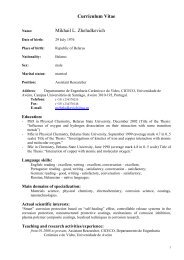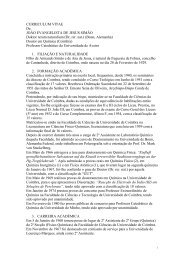XII Iberian Meeting of Electrochemistry XVI Meeting of the ...
XII Iberian Meeting of Electrochemistry XVI Meeting of the ...
XII Iberian Meeting of Electrochemistry XVI Meeting of the ...
You also want an ePaper? Increase the reach of your titles
YUMPU automatically turns print PDFs into web optimized ePapers that Google loves.
<strong>XII</strong> <strong>Iberian</strong> <strong>Meeting</strong> <strong>of</strong> <strong>Electrochemistry</strong> & <strong>XVI</strong> <strong>Meeting</strong> <strong>of</strong> <strong>the</strong> Portuguese Electrochemical Society PB 05<br />
Evaluation <strong>of</strong> gallic acid antioxidant activity based on its<br />
extensive oxidation promoted by electrochemical methods<br />
Raquel Oliveira, Juliana Marques, Fátima Bento, Dulce Geraldo, Paula<br />
Bettencourt<br />
Departament <strong>of</strong> Chemistry, Universidade do Minho, 4710-057<br />
juliana.g.marques@hotmail.com<br />
Cellular oxidative stress and oxidative degradation <strong>of</strong> foods are associated to <strong>the</strong><br />
occurrence <strong>of</strong> oxidative processes on a large scale involving reactive oxygen species<br />
(ROS) such as O 2 , H 2 O 2 , O 2 •- and HO • . The promoted oxidation reactions may involve<br />
free radicals that start chain reactions, causing large scale destruction <strong>of</strong> molecules and<br />
biological systems (such as cells). The antioxidants action on <strong>the</strong> prevention <strong>of</strong> oxidative<br />
damage is widely recognized and is associated to <strong>the</strong>ir ability to remove free radicals<br />
and to inhibit <strong>the</strong> oxidation <strong>of</strong> o<strong>the</strong>r molecules through <strong>the</strong>ir own oxidation.<br />
The identification <strong>of</strong> <strong>the</strong> activity <strong>of</strong> recognized antioxidants or <strong>of</strong> new molecules is<br />
carried out by different methods, mostly chemical, which allow characterizing <strong>the</strong><br />
reactions <strong>of</strong> <strong>the</strong>se compounds with various reactive species. The use <strong>of</strong> syn<strong>the</strong>tic radicals<br />
such as ABTS •+ (2,2'-azinobis(3-ethylbenzothiazoline-6-sulfonate)), DPPH • (2,2-<br />
diphenyl-1-picrylhydrazyl) or DMPD •+ (N,N-dimethyl-p-phenylenediamine) is common<br />
in chemical assays despite <strong>the</strong>ir lack <strong>of</strong> meaning in biological or chemical natural<br />
samples. The generation <strong>of</strong> ROS is <strong>of</strong> fundamental importance in order to carry out<br />
relevant activity tests.<br />
Electrochemical methods, such as cyclic voltammetry have been extensively used to<br />
characterize antioxidants, through <strong>the</strong> estimation <strong>of</strong> <strong>the</strong>ir standard reduction potentials,<br />
E 0 . Despite <strong>the</strong> importance <strong>of</strong> this <strong>the</strong>rmodynamic parameter, <strong>the</strong> kinetic<br />
characterization <strong>of</strong> reactions <strong>of</strong> antioxidants is crucial because it determines <strong>the</strong>ir ability<br />
to respond in time.<br />
In this paper, we present a study on <strong>the</strong> gallic acid response to a large scale oxidative<br />
attack promoted by electrochemical means. By adjusting <strong>the</strong> anode potential, <strong>the</strong> assay<br />
enables to test <strong>the</strong> antioxidant behavior against oxidants <strong>of</strong> different strength. This is an<br />
advantage toward chemical assays based on a chemical oxidant characterized by a fixed<br />
redox potential, E 0 . Ano<strong>the</strong>r advantage <strong>of</strong> <strong>the</strong> electrochemical oxidative attack is <strong>the</strong><br />
ease monitoring <strong>of</strong> <strong>the</strong> oxidation reaction rate, which is assessed directly from <strong>the</strong><br />
current, in opposition to <strong>the</strong> chemical assays that require <strong>the</strong> direct monitoring <strong>of</strong> <strong>the</strong><br />
oxidant or <strong>of</strong> a probe in a competitive assay.<br />
Acknowledgments: Fundação para a Ciência e a Tecnologia (SFRH/BD/64189/2009).<br />
September, 811, 2010. ISEL - Lisbon 71








